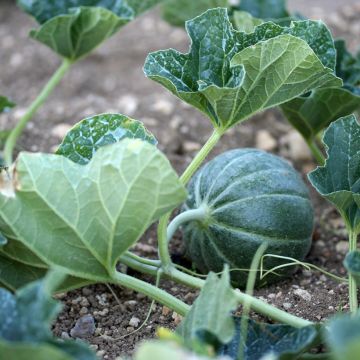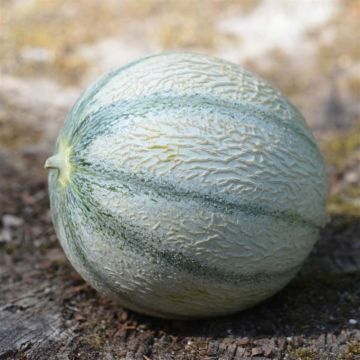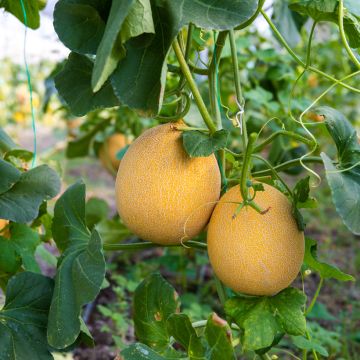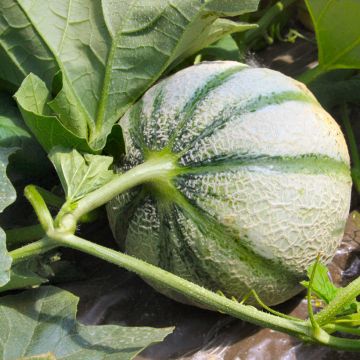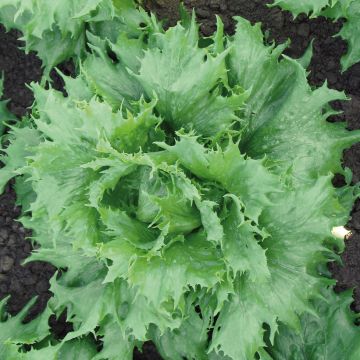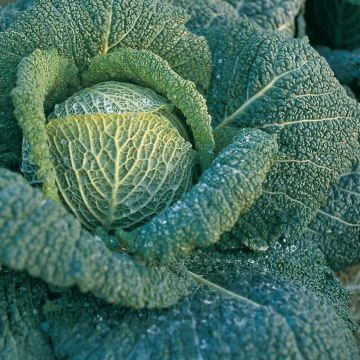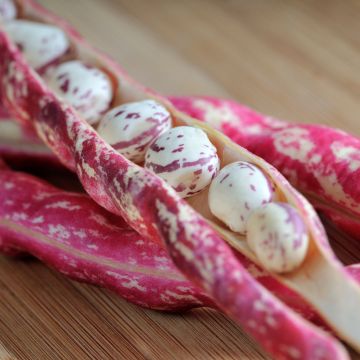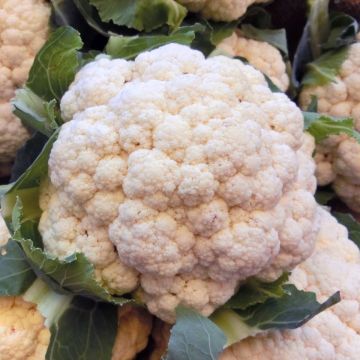

Honeydew Melon - Ferme de Sainte Marthe Seeds


Honeydew Melon - Ferme de Sainte Marthe Seeds
Honeydew Melon - Ferme de Sainte Marthe Seeds
Cucumis melo Honey Dew
Muskmelon
This item cannot be shipped to the selected country
Dispatch by letter from €3.90
More information
Schedule delivery date,
and select date in basket
This plant carries a 6 months recovery warranty
More information
We guarantee the quality of our plants for a full growing cycle, and will replace at our expense any plant that fails to recover under normal climatic and planting conditions.
Seed-only orders are dispatched by sealed envelope. The delivery charge for seed-only orders is €3.90.
Description
'Honeydew' Melon is a popular winter variety that forms slightly oval-shaped, 1 kg fruits with pale yellow rind. Flesh is fine-flavoured, sweet and juicy with a delightfully delicate aroma. A good variety for storing as the fruits will keep for 2 to 3 weeks. Sow from March to May and harvest from June to September.
The melon is a popular fruit belonging to the Cucurbitaceae family alongside gourds and squashes. It grows on annual herbaceous trailing vines and is native to central Asia, although evidence discovered in Ancient Egyptian tombs suggests that it has been cultivated in Africa for over 4000 years. Nearly all melons belong to the Cucumis melo species. This includes sweet-flavoured summer varieties such as Cantaloupes, muskmelons and netted melons, and mild-flavoured “winter” varieties (honeydew, casabas, Persian melons etc.). Melon fruits come in many shapes, sizes and colours. They can be round or oblong and have smooth, ribbed or reticulated skin. The juicy green, white, yellow or orange flesh surrounds a central seed cavity.
Melon can be eaten raw as a starter or dessert, in sorbets, jams, soups or canned in syrup. Small immature melons that are removed from the plant during thinning or pruning can be pickled in vinegar with fresh herbs. Melon is a refreshing fruit that has diuretic properties, it is known to be an excellent source of vitamins B and C as well as trace elements. Varieties with orange flesh contain vitamin A, also known as carotene.
Harvesting: Cantaloupes and muskmelons are typically ready to harvest about 4 weeks after pollination. Ripe fruit gives off a delicious sweet and musky aroma, with small cracks in the rind surrounding the stem. The stem itself is shrivelled and dry, making it easy to detach the fruit from the vine. Larger types of melon take a bit longer to ripen.
Storage: whole, uncut melons will easily keep for several days (up to 5 days) in a dry and well-ventilated place. Damaged or leftover fruit can be frozen for later use. Remove the peel and discard the seeds, cut into small pieces and spread out on a tray. Place in the freezer until firm then transfer into freezer bags.
Good to know: Placing the melons on top of a slate or roof tile will keep them from being in direct contact with the ground. This prevents them from rotting due to excessive humidity. Melon plants prefer moist soil and benefit from mulching, especially during the hotter summer months. They are very prone to powdery mildew (a fungal disease that causes a white down to form on the surface of the leaves). When watering, try to avoid getting water on the leaves or flowers. Melons are heavy feeders. Make sure to rotate your crops to prevent the soil from wearing out. Melon plants associate well with members of the Fabaceae family (formerly legumes) such as beans or peas. Avoid growing them next to cucumber or squash plants.
NB. Organic seeds (in French "AB" for "Agriculture Biologique") are produced from plants that aren't treated with phytosanitary products (insecticides, weed killers). The seeds do not undergo post-harvest treatment. They carry the AB label and are approved by Ecocert, an independent structure.
Report an error about the product description
Harvest
Plant habit
Foliage
Botanical data
Cucumis
melo
Honey Dew
Cucurbitaceae
Muskmelon
Cultivar or hybrid
Annual
Other Melon seeds
Planting and care
Soil preparation: melon plants like cool, well-drained soil. Prepare the soil by loosening the top 10 cm without turning it over. Melons need plenty of food and warmth to produce fruit. Fill the planting hole with manure or well-decomposed compost and mix it with the soil to prevent the roots from burning. Choose a very sunny spot with sandy, well-drained soil with a slightly acidic pH.
Sowing under cover: melons are best-suited to warmer climates. It is often a good idea to sow them in a greenhouse or propagator and to transplant them when the outdoor temperatures are more favorable. In late March, fill pots or seed trays with sowing mix and sow the melon seeds with the tips pointing down to help root development. Water lightly and keep the soil moist. Germination usually takes 14 days. When the young plants have three true leaves and the soil has warmed up (between 18 and 26°C), they can be transplanted in their final location. Make sure to leave 80 cm between each plant.
Direct sowing: in warmer climates, melons can be sown outdoors. Make sure the soil temperature is high enough before sowing (between 18 and 26°C). Then place two to three seeds in seed holes with the tips pointing downwards. Leave at least 80 cm between each seed hole. Water lightly and keep the soil moist at all times. When the seedlings have three true leaves, thin them out by keeping the strongest one.
Seedlings
Care
Intended location
This item has not been reviewed yet - be the first to leave a review about it.
Vegetable seeds
Haven't found what you were looking for?
Hardiness is the lowest winter temperature a plant can endure without suffering serious damage or even dying. However, hardiness is affected by location (a sheltered area, such as a patio), protection (winter cover) and soil type (hardiness is improved by well-drained soil).

Photo Sharing Terms & Conditions
In order to encourage gardeners to interact and share their experiences, Promesse de fleurs offers various media enabling content to be uploaded onto its Site - in particular via the ‘Photo sharing’ module.
The User agrees to refrain from:
- Posting any content that is illegal, prejudicial, insulting, racist, inciteful to hatred, revisionist, contrary to public decency, that infringes on privacy or on the privacy rights of third parties, in particular the publicity rights of persons and goods, intellectual property rights, or the right to privacy.
- Submitting content on behalf of a third party;
- Impersonate the identity of a third party and/or publish any personal information about a third party;
In general, the User undertakes to refrain from any unethical behaviour.
All Content (in particular text, comments, files, images, photos, videos, creative works, etc.), which may be subject to property or intellectual property rights, image or other private rights, shall remain the property of the User, subject to the limited rights granted by the terms of the licence granted by Promesse de fleurs as stated below. Users are at liberty to publish or not to publish such Content on the Site, notably via the ‘Photo Sharing’ facility, and accept that this Content shall be made public and freely accessible, notably on the Internet.
Users further acknowledge, undertake to have ,and guarantee that they hold all necessary rights and permissions to publish such material on the Site, in particular with regard to the legislation in force pertaining to any privacy, property, intellectual property, image, or contractual rights, or rights of any other nature. By publishing such Content on the Site, Users acknowledge accepting full liability as publishers of the Content within the meaning of the law, and grant Promesse de fleurs, free of charge, an inclusive, worldwide licence for the said Content for the entire duration of its publication, including all reproduction, representation, up/downloading, displaying, performing, transmission, and storage rights.
Users also grant permission for their name to be linked to the Content and accept that this link may not always be made available.
By engaging in posting material, Users consent to their Content becoming automatically accessible on the Internet, in particular on other sites and/or blogs and/or web pages of the Promesse de fleurs site, including in particular social pages and the Promesse de fleurs catalogue.
Users may secure the removal of entrusted content free of charge by issuing a simple request via our contact form.
The flowering period indicated on our website applies to countries and regions located in USDA zone 8 (France, the United Kingdom, Ireland, the Netherlands, etc.)
It will vary according to where you live:
- In zones 9 to 10 (Italy, Spain, Greece, etc.), flowering will occur about 2 to 4 weeks earlier.
- In zones 6 to 7 (Germany, Poland, Slovenia, and lower mountainous regions), flowering will be delayed by 2 to 3 weeks.
- In zone 5 (Central Europe, Scandinavia), blooming will be delayed by 3 to 5 weeks.
In temperate climates, pruning of spring-flowering shrubs (forsythia, spireas, etc.) should be done just after flowering.
Pruning of summer-flowering shrubs (Indian Lilac, Perovskia, etc.) can be done in winter or spring.
In cold regions as well as with frost-sensitive plants, avoid pruning too early when severe frosts may still occur.
The planting period indicated on our website applies to countries and regions located in USDA zone 8 (France, United Kingdom, Ireland, Netherlands).
It will vary according to where you live:
- In Mediterranean zones (Marseille, Madrid, Milan, etc.), autumn and winter are the best planting periods.
- In continental zones (Strasbourg, Munich, Vienna, etc.), delay planting by 2 to 3 weeks in spring and bring it forward by 2 to 4 weeks in autumn.
- In mountainous regions (the Alps, Pyrenees, Carpathians, etc.), it is best to plant in late spring (May-June) or late summer (August-September).
The harvesting period indicated on our website applies to countries and regions in USDA zone 8 (France, England, Ireland, the Netherlands).
In colder areas (Scandinavia, Poland, Austria...) fruit and vegetable harvests are likely to be delayed by 3-4 weeks.
In warmer areas (Italy, Spain, Greece, etc.), harvesting will probably take place earlier, depending on weather conditions.
The sowing periods indicated on our website apply to countries and regions within USDA Zone 8 (France, UK, Ireland, Netherlands).
In colder areas (Scandinavia, Poland, Austria...), delay any outdoor sowing by 3-4 weeks, or sow under glass.
In warmer climes (Italy, Spain, Greece, etc.), bring outdoor sowing forward by a few weeks.



































